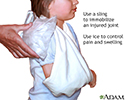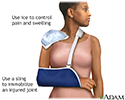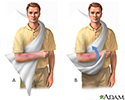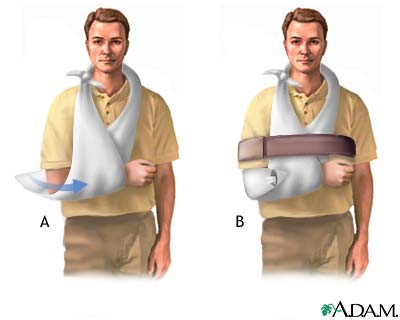How to make a sling
Sling - instructions
A sling is a device used to support and keep still (immobilize) an injured part of the body.
Slings can be used for many different injuries. They are most often used when you have a broken (fractured) or dislocated arm, elbow, or shoulder.
Considerations
If an injury needs a splint, apply the splint first and then apply the sling.
Always check the person's skin color and pulse (circulation) after the injured body part has been splinted. Loosen the splint and bandage if:
- The area becomes cool or turns pale or blue
- Numbness or tingling develops in the injured body part
Injuries to nerves or blood vessels often occur with an arm injury. The health care provider should check circulation, movement, and feeling in the injured area often.
The purpose of a splint is to prevent movement of the broken or dislocated bone. Splints reduce pain, and help prevent further damage to muscles, nerves, and blood vessels. Splinting also reduces the risk of a closed injury becoming an open injury (an injury in which bone sticks through the skin).
First Aid
Care for all wounds before applying a splint or sling. If you can see bone in the injured site, call your local emergency number (such as 911) or local hospital for advice.
HOW TO MAKE A SLING
- Find a piece of cloth that is about 5 feet (1.5 meters) wide at the base and at least 3 feet (1 meter) long on the sides. (If the sling is for a child, you can use a smaller size.)
- Cut a triangle out of a piece of this cloth. If you don't have scissors handy, fold a large square piece of cloth diagonally into a triangle.
- Place the person's elbow at the top point of the triangle, and the wrist midway along the triangle's bottom edge. Bring the two free points up around the front and back of the same (or opposite) shoulder.
- Adjust the sling so the arm rests comfortably, with the hand higher than the elbow. The elbow should be bent at a right angle.
- Tie the sling together at the side of the neck and pad the knot for comfort.
- If the sling was placed correctly, the person's arm should rest comfortably against their chest with the fingertips exposed.
Other tips:
- If you do not have material or scissors to make a triangle sling, you can make one using a coat or a shirt.
- You can also make a sling using a belt, rope, necktie, or sheet.
- If the injured arm should be kept still, tie the sling to the body with another piece of cloth wrapped around the chest and tied on the uninjured side.
- Occasionally check for tightness, and adjust the sling as needed.
- Remove wrist watches, rings, and other jewelry from the arm.
Do Not
DO NOT try to realign an injured body part unless the skin looks pale or blue, or there is no pulse.
When to Contact a Medical Professional
Seek medical help right away if the person has a dislocation, broken bone, or severe bleeding. Also get medical help if you cannot completely immobilize the injury at the scene by yourself.
Prevention
Safety is the best way to avoid broken bones caused by falling. Some diseases make bones break more easily. Use caution when helping a person with fragile bones.
Take care during activities that strain the muscles or bones for long periods of time, as these can cause weakness and falls. Use care when walking on slippery or uneven surfaces.
References
Auerbach PS. Fractures and dislocations. In: Auerbach PS, ed. Medicine for the Outdoors. 6th ed. Philadelphia, PA: Elsevier; 2016:67-107.
Kalb RL, Fowler GC. Fracture care. In: Fowler GC, ed. Pfenninger and Fowler's Procedures for Primary Care. 4th ed. Philadelphia, PA: Elsevier; 2020:chap 178.
Klimke A, Furin M, Overberger R. Prehospital immobilization. In: Roberts JR, Custalow CB, Thomsen TW, eds. Roberts and Hedges' Clinical Procedures in Emergency Medicine and Acute Care. 7th ed. Philadelphia, PA: Elsevier; 2019:chap 46.
Triangular shoulder sling - illustration
Triangular shoulder sling
illustration
Shoulder sling - illustration
Shoulder sling
illustration
Creating a sling - series
Presentation
Review Date: 11/13/2021
Reviewed By: Jesse Borke, MD, CPE, FAAEM, FACEP, Attending Physician at Kaiser Permanente, Orange County, CA. Also reviewed by David Zieve, MD, MHA, Medical Director, Brenda Conaway, Editorial Director, and the A.D.A.M. Editorial team.











